 , 魏敏1,2, 宁文涛3, 张美根4, 李侃5, 江伟5, 刘厚凤1,2
, 魏敏1,2, 宁文涛3, 张美根4, 李侃5, 江伟5, 刘厚凤1,2

1. 山东师范大学地理与环境学院, 济南 250358;
2. 山东师范大学环保技术与政策研究中心, 济南 250014;
3. 山东师范大学图书馆, 济南 250014;
4. 中国科学院大气物理研究所, 大气边界层物理与大气化学国家重点实验室, 北京 100029;
5. 威海市市区环境监控中心, 威海 264200
收稿日期: 2020-05-29; 修回日期: 2020-07-09; 录用日期: 2020-07-09
基金项目: 国家自然科学基金青年项目(No.41605113);中国博士后科学基金面上项目(No.2018M632713)
作者简介: 邢芝雯(1997-), 女, E-mail: 1517222509@qq.com
通讯作者(责任作者): 刘厚凤(1965—), 女, 教授、研究生导师, 研究方向:大气环境方向研究, 侧重于大气物理、大气环境计算模拟、污染物区域输送方面研究, 发表该方向研究论文30余篇. E-mail: 110027@sdnu.edu.cn
摘要:威海市是山东省东部最典型的沿海城市,也是中国、日本、韩国大气污染相互传输影响的重要通道.虽然威海市大气质量已连续4年达标,但其污染仍时有反弹.2019年1-2月威海市大气NO2和PM2.5浓度反弹率分别达48.5%和35.0%,明显高于山东省内陆地区和京津冀地区平均水平.通过对同期空气质量例行监测数据和气象资料统计分析、空气质量模型RAMS-CMAQ模拟和后向轨迹聚类等方法定量剖析了威海市大气污染反弹的原因.结果表明,威海市2019年1-2月空气污染反弹与气象条件及其相关联的污染物区域输送有较大的相关性,与2018年同期相比,冷空气活动弱、降水量偏少、风速偏低、受来自山东内陆和京津冀相对高污染区污染输送影响偏多是造成本次污染反弹的主要诱因.RAMS-CMAQ模拟显示,相同排放源假定下,由气象条件及其引起的区域传输造成的PM2.5和NO2浓度反弹,2019年1、2月较2018年同期PM2.5浓度增加值分别为8、3 μg·m-3,分别占总反弹率的53%、37.5%,NO2浓度增加值分别为10、7.5 μg·m-3,分别占总反弹率的58.8%、40%.说明威海市空气质量受外来输送明显、扩散条件及区域污染输送是空气质量评估不容忽视的重要因素.
关键词:污染反弹气象因素RAMS-CMAQ后向轨迹威海市
Study on the cause of air pollution rebound in Weihai in early 2019 based on RAMS-CMAQ simulation
XING Zhiwen1,2
 , WEI Min1,2, NING Wentao3, ZHANG Meigen4, LI Kan5, JIANG Wei5, LIU Houfeng1,2
, WEI Min1,2, NING Wentao3, ZHANG Meigen4, LI Kan5, JIANG Wei5, LIU Houfeng1,2

1. College of Geography and Environment, Shandong Normal University, Jinan 250358;
2. Center for Environmental Technology and Policy Research, Shandong Normal University, Jinan 250014;
3. Shandong Normal University Library, Jinan 250014;
4. State Key Laboratory of Atmospheric Boundary Layer Physics and Atmospheric Chemistry, Institute of Atmospheric Physics, Chinese Academy of Sciences, Beijing 100029;
5. Weihai City Environmental Monitoring Center, Weihai 264200
Received 29 May 2020; received in revised from 9 July 2020; accepted 9 July 2020
Abstract: As a typical coastal city in Shandong Province,Weihai is located on the important transmission channel of atmospheric pollutants among China,Japan and South Korea. Although the air quality had met the grade for four years,the level of pollutants still raised frequently. From January to February in 2019, the rebound rate for PM2.5 and NO2 reached 48.5% and 35.0%,which was significantly higher than the average rate of inland area in Shandong Province and Beijing-Tianjin-Hebei region. In this study,the air quality monitoring and meteorological data in Weihai were conducted,moreover,RAMS-CMAQ air quality model and backward trajectory clustering were employed to analyze pollution rebound process quantificationally. The results revealed that air pollution rebound in Weihai from January to February in 2019 had an obvious correlation with meteorological conditions. Compared with the same period in 2018, weaker cold air activities,lower precipitation,wind speed and effect by air-masses transported from the relatively high pollution areas,including inland of Shandong Province and Beijing-Tianjin-Hebei region would aggravate pollution. Under the same emission intensity,RAMS-CMAQ simulation showed that the rebounds of PM2.5 and NO2 concentration cause by meteorological diffuse condition and air-mass transmission,the increase in PM2.5 concentration in January and February 2019 compared with the same period in 2018 was 8 and 3 μg·m-3,accounting for 53% and 37.5% of the total rebound rate,and the increase in NO2 concentration was 10 and 7.5 μg·m-3 accounting for 58.8% and 40% of the total rebound rate respectively. The simulation results implied the air quality in Weihai was markedly influenced by air-mass transport. Therefore,diffusion conditions and regional transport should not be ignored in air quality assessment.
Keywords: air pollution reboundmeteorological factorsRAMS-CMAQbackward trajectoryWeihai
1 引言(Introduction)近年来我国大部分区域PM2.5质量浓度下降明显, 减排措施在空气污染改善中发挥了重要作用(Zhu et al., 2020; Zhang et al., 2020; Dong et al., 2020), 但气象条件的波动也会在很大程度上影响大气污染物浓度.辨识导致空气质量变化的具体原因, 是当前影响政府考核地方空气质量管控水平和制定准确污染防控政策过程中亟需解决的问题(徐祥德等, 2015; Zhang et al., 2018;张小曳等, 2020).
当前国内外****对空气质量与气象因素的相关性进行了大量研究(Huang et al., 2014;张人禾等, 2014;何建军等, 2016;石晓雪等, 2019).徐冉等(2019)对北京地区2016—2017年秋冬季大气重污染时段的颗粒物浓度、气象要素和气团传输路径综合研究表明, 地面受弱气压场控制、高湿度、静小风及较低的混合层高度, 加之北京三面环山的特殊地势是导致秋冬季静稳态型污染频发的重要因素;许建明等(2016)采用PCT方法对上海市2012—2015年每年11月、12月和次年1月的PM2.5质量浓度与气压场风场关系进行分析, 并得出了秋冬季PM2.5易污染的4种天气环流类型.有关气象条件对空气质量的定量影响研究则多采用空气质量模型(Guo et al., 2019;Liu et al., 2020; Liu et al., 2020).例如, Zhang等(2019)利用CMAQ模型研究了青岛市冬季污染过程, 发现天气形势造成的水平和垂直传输对PM2.5的贡献率上升为19.7%~42.2%;Zhong等(2018a)利用CUACE/Chem模型模拟的北京2013—2016年重污染期间边界层湍流扩散系数迅速从100 m2·s-1降到50 m2·s-1;尹小梅等(2019)利用WRF-CHEM模型对北京市空气质量进行模拟, 发现气象要素的改变导致2017年12月北京PM2.5浓度较2014—2016年同期分别降低5%、38%和25%;张小曳等(2020)利用污染-气象条件指数(PLAM指数)研究冬季京津冀地区气象条件对PM2.5浓度的影响, 发现不利的气象条件可导致PM2.5浓度较其他季节上升约40%~100%.国内针对气象对空气质量影响的研究多集中在京津冀、珠三角、长三角、川渝盆地、汾渭平原等地区(张人禾等, 2014; 刘厚凤等, 2015;Wu et al., 2017; Zhong et al., 2018b).
威海市(37.5°N, 122.1°E)位于山东半岛东端, 三面环海, 受海洋清洁气团影响显著, 具有良好的污染物扩散条件.但受大范围区域污染过程及本地不利气象条件影响, 威海市空气质量会出现阶段性反弹.本研究采用气象资料分析和RAMS-CMAQ空气质量模拟相结合的方法, 探讨2019年1—2月间威海市空气质量反弹的气象原因的影响, 以期为威海市空气质量管控和考核提供参考.
2 研究方法(Research methods)2.1 数据来源威海市2018年和2019年1—2月大气监测数据(AQI、SO2、NO2、CO、O3、PM10、PM2.5)来自于山东省空气监测站例行监测平台, 威海市常规监测站点分布见图 1;气温、气压、相对湿度、风速、降水等气象数据来源于中国气象局威海市文登大气边界层观测站(37.22°N, 112.07°E, 台站编号54777).后向轨迹模式运用的气象资料来源于美国国家环境预报中心(NECP)提供的GDAS数据(http://ready.arl.noaa.gov/HYSPLIT_traj.php). 2019年与2018年同期相比空气质量反弹率=(2019年某指标值-2018年同期指标值)/2018年同期指标值×100%.
图 1(Fig. 1)
 |
| 图 1 威海市常规监测站点分布 Fig. 1Location of routine monitoring stations in Weihai City |
空气质量模拟使用的污染源清单为2019年人为源排放清单, 此清单是在清华大学张强团队提供的分辨率为0.25°×0.25°的2016年月均源排放清单(Li et al., 2017)的基础上, 结合相关研究(Tong et al., 2020)的估算结果.该清单包括了黑碳(BC)、OC、CO、CO2、SO2、NOx、非甲烷VOCs(NMVOCs)、NH3、PM10和PM2.5.生物源来自于MEGAN(the Model of Emission of Gases and Aerosols from Nature)(Guenther et al., 2012).闪电产生的NOx源排放数据主要来自于分辨率为1°×1°的GEIA(the Global Emission Inventory Activity)月均源清单(Benkovitz et al., 1999).外场生物质燃烧排放数据由GFEDv4(the Global Fire Emissions Database Version 4)提供(Randerson et al., 2017).模式中还引入分别由Han等(2004)和Gong等(2003)发展的在线沙尘和海盐排放计算模块.
2.2 后向轨迹聚类由美国国家海洋大气研究中心空气资源实验室(NOAA)开发的后向轨迹模式HYSPLIT (Draxler et al., 2001)是拉格朗日和欧拉混合型的扩散模式, 目前, 国内外****在分析污染物来源及确定污染物的传输路径中也会用到此模式.
后向轨迹聚类分析采用轨迹欧式距离法(EUCLIDEAN)对抵达威海市的所有气流轨迹进行分型聚类, 得到不同类型的输送气流及其影响频率, 由此分析对不同来源气团对研究区域污染物浓度的影响.具体为:计算相邻两条后向轨迹之间的距离后根据轨迹的空间相异度对轨迹分型聚类, 即设有n条轨迹, 选取其中距离最近的2条作为一类并计算它们每小时滞留点的平均轨迹.计算每条聚类空间的相异度SPVAR, 最后通过总空间相异度TSV(所有SPVAR之和)与n之间的关系判断轨迹轨迹分型的数目和每类平均轨迹的空间分布情况(Guo et al., 2019;王醒等, 2019).
2.3 空气质量模式RAMS-CMAQ本研究采用的空气质量模式系统RAMS-CMAQ是在美国环保署新一代空气质量模式Models-3的核心模块CMAQ (Community Multiscale Air Quality modeling system)的基础上发展起来的, 代表了当前空气质量模式的发展趋势.CMAQ包括了气相化学与气-固转换等化学机制、水平与垂直扩散输送、液相化学与干湿沉降、气溶胶的核化、碰并与增长等物理与化学过程.其所需的初始浓度场、侧边界条件、污染物光解速率等资料需要借助初始场诊断模块、侧边界处理模块和光解速率计算模块等数值模块而获得.为了更好地解析大气边界层下层地表非均匀性强迫对大气输送扩散能力的影响和污染物浓度分布与边界层结构的垂直变化, 这里采用区域大气模拟系统RAMS(Regional Atmospheric Modeling System)来为CMAQ提供气象驱动场(张美根, 2005; Kou et al., 2015; Liu et al., 2018; Li et al., 2019), RAMS气象模拟的可靠性已在文献中被广泛证实(Wang et al., 2017;Han et al., 2018; Li et al., 2019).
本研究选取的模拟区域如图 2所示.模式网格的水平分辨率为16 km×16 km, 水平网格为94×90.在垂直方向上, RAMS和CMAQ的模式顶高度相同, 约为13 km.RAMS将其分为24层, 其网格距在近地层较小(第1整层的厚度为40 m, 有10层位于2 km以下, 以解析大气边界层下层地表非均匀性强迫对局地环流和大气边界层垂直结构的影响), 而后随高度增加而加大(最大值为1500 m);CMAQ分为15层, 其中最下面的6层与RAMS的相同, 以便详细描述大气近地层中污染物的输送扩散、化学转化与干湿沉降过程.
图 2(Fig. 2)
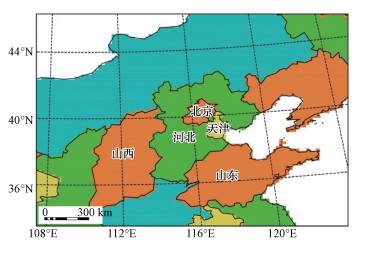 |
| 图 2 本研究中CMAQ模拟范围 Fig. 2The model domain for CMAQ used in this study |
大量研究表明, RAMS-CMAQ模型在模拟气象参数和主要气溶胶成分方面已得到广泛应用(Zhang et al., 2006;Han et al., 2016; Li et al., 2019).表 1将模拟的PM2.5浓度与威海市7个站点(图 1)的高污染和低污染连续时段(1月1日0:00—2月1日24:00)模拟值与地面观测值进行了评估, 发现模拟值与观测值均值接近, 但模拟值的标准差高于观测值, 说明模拟值的离散程度略高, 整体上除了张村站点的分数偏差(Fractional Bias, FB)不满足要求以外, 其他点位均满足模拟效果评估要求.模拟效果评估公式见式(1)~(2).
表 1(Table 1)
| 表 1 威海市7个站点PM2.5模拟值与实测值的比较 Table 1 Comparison between stimulated concentrations and ground observations of PM2.5 in 7 stations of Weihai | |||||||||||||||||||||||||||||||||||||||||||||||||||||||||||||||||||||||||||||||||
表 1 威海市7个站点PM2.5模拟值与实测值的比较 Table 1 Comparison between stimulated concentrations and ground observations of PM2.5 in 7 stations of Weihai
| |||||||||||||||||||||||||||||||||||||||||||||||||||||||||||||||||||||||||||||||||
 | (1) |
 | (2) |
3 结果与讨论(Result and discussion)3.1 威海市2018年、2019年1—2月同期空气质量比较对威海市空气质量及每日首要污染物的统计表明, 2018年1、2月空气质量优良天数为52 d, 轻度污染7 d, 无中度和重度污染天气;2019年同期优良天数48 d, 轻度污染4 d, 中度污染5 d, 重度污染2 d.相较于2018年, 威海市2019年污染天数增加, 首要污染物为PM2.5.
2019年1、2月威海市的常规污染物平均浓度与2018年同期平均浓度见图 3.由图可知, 2019年1—2月PM2.5、PM10、CO、NO2和SO2平均浓度分别为49 μg·m-3、85 μg·m-3、1.5 mg·m-3、27 μg·m-3和10 μg·m-3, 同比上升48.5%、37.1%、36.4%、35.0%和11.1%, O3浓度为98 μg·m-3, 同比下降1.0%.1月PM2.5、NO2、PM10和CO浓度分别为49 μg·m-3、33 μg·m-3、88 μg·m-3和1.7 mg·m-3, 反弹率较高, 分别为44.1%、32.0%、31.3%和30.8%;2月NO2、PM2.5和PM10为反弹率较高的污染物, 浓度分别为22、49和81 μg·m-3, 反弹率分别为57.1%、53.1%和44.6%.
图 3(Fig. 3)
 |
| 图 3 威海市2018年、2019年1、2月常规污染物浓度同期对比 Fig. 3Comparison of concentrations of conventional pollutants in the same period of 2018 and 2019 in Weihai City |
山东省各地市同期6种常规污染物平均浓度、反弹率比较(图 4)可见, 除O3外, 沿海城市其他污染物浓度明显低于内陆城市.全省1、2月SO2、NO2、CO、O3、PM10和PM2.5平均反弹率分别为-14.8%、11.7%、-2.1%、0.3%、16.7%和24.0%, 除O3外, 威海的污染物反弹率最高, 远超全省的平均反弹率.
图 4(Fig. 4)
 |
| 图 4 山东省各市1、2月污染物浓度均值及同期对比 Fig. 4The comparison of pollutant average concentrations of January and February in 2018 and 2019 in 17 cities of Shandong Province |
3.2 威海市空气污染反弹的气象原因剖析在稳定排放源的条件下, 污染物浓度变化很大程度上取决于气象条件(孙兆彬等, 2017;李敏等, 2018;Zhou et al., 2018).本研究统计了2018、2019年同期的温度、湿度、降水量、风向和风速等气象因素及PM2.5浓度(图 5).
图 5(Fig. 5)
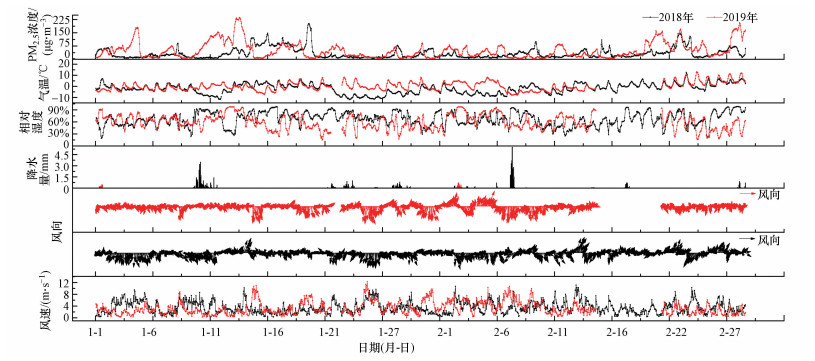 |
| 图 5 2018年和2019年1、2月同期气象因素对比 Fig. 5Comparison of meteorological factors in January and February in 2018 and 2019 |
由图 5可见, PM2.5高浓度对应着高温、高湿、小风等气象特征, 降水对污染物具有明显的清除作用.2018年和2019年1、2月同期的水平风速、风向对比发现, 2018年风速(3.48 m·s-1)高于2019年(3.08 m·s-1).2019年1月与2018年1月最大风频均为北风, 但2019年北风风速偏小, 2018年1月西南风频率也较大(图 6).2019年小风(风速≤1.5 m·s-1)频率(23.3%)明显高于2018年(17.1%), 说明污染物扩散稀释能力相对较弱(姚海涛等, 2015;程念亮等, 2016).
图 6(Fig. 6)
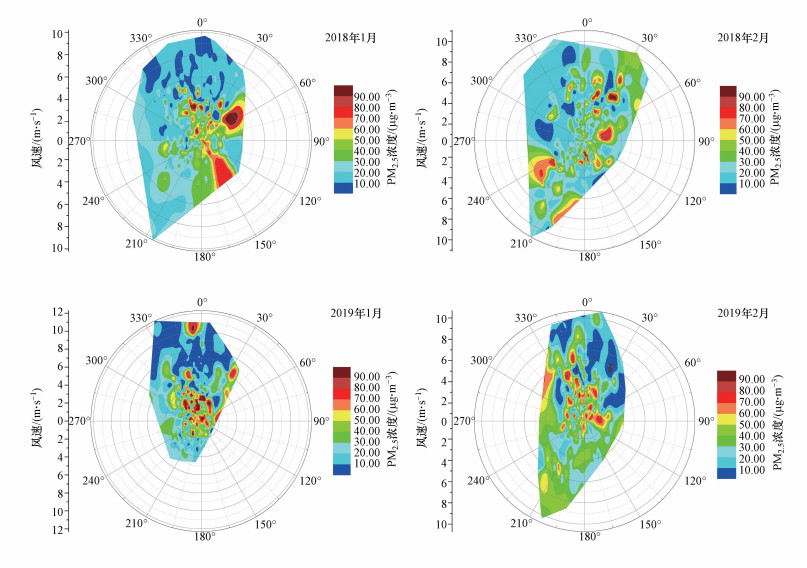 |
| 图 6 2018年和2019年1、2月污染玫瑰图 Fig. 6Concentration distribution of PM2.5 in Weihai city in January and February of 2018 and 2019 |
由表 2可见, 2019年1、2月气温比2018年同期偏高, 月均温度高2 ℃左右, 意味着受冷空气影响弱, 易导致污染物浓度升高(Robert et al., 2010;何建军等, 2016; Li et al., 2017).2019年1、2月总降水量(6.4 mm)远低于2018年同期(73.2 mm), 说明2019年对颗粒物的湿沉降作用不利(韩力慧等, 2017;何林宴等, 2019;杨茜等, 2019).降水量大、降水日数多, 导致2019年同期相对湿度均值(58.9%)较2018年(66.8%)低.当60% < 湿度 < 80%时, 高湿度有利于污染物吸湿加重污染强度(白永清等, 2016;王超等, 2018;尹单丹等, 2019).综合各气象因素, 2019年除相对湿度外, 其余气象因素均对污染物扩散稀释不利.
表 2(Table 2)
| 表 2 2018年和2019年1、2月同期污染物与气象要素对比 Table 2 Comparison of pollutants and meteorological elements in January and February of 2018 and 2019 | ||||||||||||||||||||||||||||||||||||||||||||||||||||||||||||||||||||||||||||||||||||||||||||||
表 2 2018年和2019年1、2月同期污染物与气象要素对比 Table 2 Comparison of pollutants and meteorological elements in January and February of 2018 and 2019
| ||||||||||||||||||||||||||||||||||||||||||||||||||||||||||||||||||||||||||||||||||||||||||||||
3.3 威海市气流轨迹聚类分析为研究不同年份威海市PM2.5外来输送特征, 选取威海市文登区园林局站点(37.22°N, 112.07°E, 台站编号54777)为受点位置, 高度500 m, 后向追溯的时间尺度为24 h, 时间为北京时间8:00(UTC时间0:00), 分别模拟了2018年和2019年1、2月气团的后向轨迹分布, 并进行聚类分析(图 7).各轨迹聚类对应的PM2.5浓度见图 8.
图 7(Fig. 7)
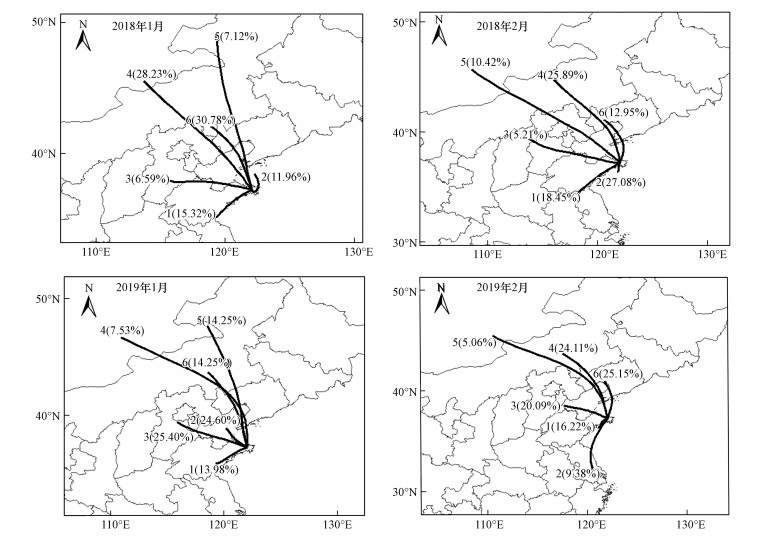 |
| 图 7 观测期间后向轨迹聚类 Fig. 7Backward trajectory clustering during observation period |
图 8(Fig. 8)
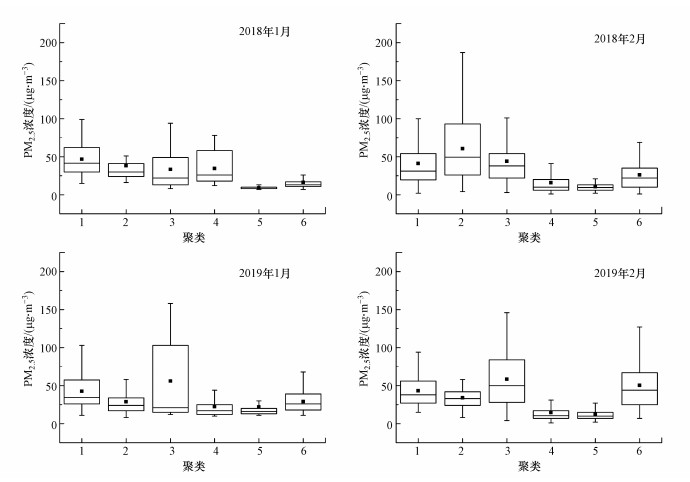 |
| 图 8 观测期间各后向轨迹聚类对应的PM2.5平均浓度 Fig. 8PM2.5 average concentration of each backward trajectory cluster during the observation period |
聚类结果显示, 2019年1月来自污染相对较严重的第1类(青岛、日照方向)和第3类气团(河北省)的影响机率分别为13.98%和25.40%, 高于2018年1月的15.32%和6.59%, 说明2019年1月威海受其他区域污染传输影响程度高于2018年1月;相反2019年1月受来自北方低污染区总的影响机率(36.03%, 第4、5、6类)小于2018年同期的66.13%, 2018年1月第4类气团PM2.5浓度比2019年同期较高, 与途径蒙古高原和内蒙古等地的沙漠戈壁的沙尘有关.
2019年2月来自较清洁的海洋方向的第2类气团频率(9.38%)和来自偏北方向的第4、5类气团的频率(24.11%、5.06%)均低于2018年2月(第2类气团频率:27.08%, 偏北方向第4、5、6类气团频率:49.26%).而来自污染程度较高的西南方向的第1类气团和来自西北京津冀方向的第3类气团频率(16.22%、20.09%), 高于2018年2月(18.45%、5.21%).2019年2月第6类气团来自辽宁锦州一带, 根据空气质量资料查询, 其2月PM2.5浓度相对较高, 尤其是2月19—21日PM2.5浓度超过200 μg·m-3.故2019年2月PM2.5浓度亦同比升高.
与2018年同期相比, 2019年1、2月影响威海的气团来自内陆污染区域的频率相对较多, 来自清洁区域的频率较低, 是导致威海市2019年空气质量较2018年差的另一原因.
3.4 空气污染反弹成因的数值模拟为了进一步厘清气象条件对威海市污染物浓度反弹的影响, 本研究选取了反弹较严重的大气污染物PM2.5和NO2, 采用相同的排放源清单, 利用RAMS-CMAQ空气质量模式分别模拟了以2018年和2019年1、2月的气象场及污染物浓度时空分布.
模拟结果显示(图 9), 2018年1月威海市PM2.5浓度区域分布由东南(25~50 μg·m-3)向西部(50~75 μg·m-3)增加, 2019年1月PM2.5浓度整体偏高(50~75 μg·m-3), 实测PM2.5浓度较2018年同期上升15 μg·m-3, 气象条件差异影响造成PM2.5浓度升高达到8 μg·m-3左右.2018年1月NO2浓度模拟值为10~20 μg·m-3, 2019年1月NO2模拟浓度有所上升, 浓度范围为10~30 μg·m-3, 2019年实测NO2浓度较2018年上升8 μg·m-3, 气象影响造成浓度升高3 μg·m-3左右.
图 9(Fig. 9)
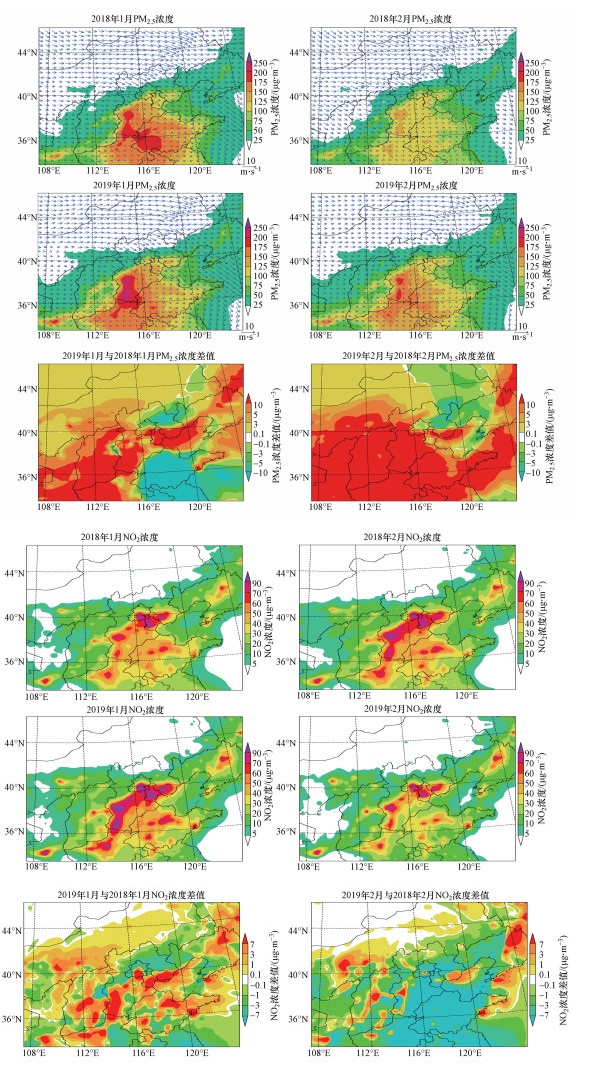 |
| 图 9 2018年和2019年1、2月PM2.5和NO2浓度及其差值分布 Fig. 9Distribution of PM2.5 and NO2 concentrations and their difference in January and February in 2018 and 2019 |
受气象因素影响, 2019年2月PM2.5模拟浓度较2018年同期上升10 μg·m-3左右, 而实测PM2.5浓度上升17 μg·m-3;NO2模拟浓度较2018年同期上升3 μg·m-3, 实测NO2浓度升高7.5 μg·m-3.因此, 排除污染排放的影响, 气象原因对威海市1月份PM2.5和NO2浓度反弹贡献率分别为53%、37.5%.气象原因对威海市2月份PM2.5和NO2浓度反弹贡献率分别为58.8%、40%.
4 结论(Conclusions)1) 2019年1—2月威海市空气质量较2018年同期反弹较大, NO2和颗粒物反弹尤为明显, NO2和PM2.5浓度分别上升6、12 μg·m-3, 反弹率分别为48.5%、35.0%.
2) 2019年1—2月与2018年同期气象要素对比发现, 2019年平均气温较2018年上升2 ℃, 相对湿度同比下降8%, 降水量较2018年同期偏少66 mm, 平均风速同比降低0.4 m·s-1, 可见2019年本地大气扩散和净化条件较差, 对空气质量反弹有重要影响.
3) 后向轨迹聚类和污染风玫瑰图分析表明, 2019年气团输送来源对本地空气质量产生不利影响, 2019年1月威海受来自北、西北方向较清洁气团的影响机率(36.03%)远低于2018年1月(66.13%), 2019年2月来自山东省西、西南方向相对高污染区的气团输送影响机率(36.31%)高于2018年同期(23.66%).
4) RAMS-CMAQ模拟结果表明, 相同排放源的条件下, 气象条件差异造成的2019年1月较2018年1月PM2.5和NO2浓度增值分别为8、3 μg·m-3, 分别占总反弹率为53%、37.5%, 2月PM2.5和NO2浓度增值分别为10、7.5 μg·m-3, 分别占总反弹率的58.8%、40%.
参考文献
| 白永清, 祁海霞, 刘琳, 等. 2016. 武汉大气能见度与PM2.5浓度及相对湿度关系的非线性分析及能见度预报[J]. 气象学报, 74(2): 189-199. |
| Benkovitz C M, Graedel T E, Kleiman G, et al. 1999. Global emissions of hydrogen chloride and chloromethane from coal combustion, incineration and industrial activities: Reactive Chlorine Emissions Inventory[J]. Journal of Geophysical Research: Atmospheres, 104(D7): 8391-8403. DOI:10.1029/1999JD900025 |
| 程念亮, 张大伟, 李云婷, 等. 2016. 风向对北京市重污染日PM2.5浓度分布影响研究[J]. 环境科学与技术, 39(3): 143-149. |
| Dong Z Y Z, Chen W Q, Wang S J. 2020. Emission reduction target, complexity and industrial performance[J]. Journal of Environmental Management, 260: 110148. DOI:10.1016/j.jenvman.2020.110148 |
| Draxler R R, Gillette D A, Kirkpatrick J S, et al. 2001. Estimating PM10 air concentrations from dust storms in Iraq, Kuwait and Saudi Arabia[J]. Atmospheric Environment, 35(25): 4315-4330. DOI:10.1016/S1352-2310(01)00159-5 |
| Gong S L, Zhang X Y, Zhao T L, et al. 2003. Characterization of soil dust aerosol in China and its transport and distribution during 2001 ACE-Asia: 2. Model simulation and validation[J]. Journal of Geophysical Research: Atmospheres, 108(D9): 4516. |
| Guenther A B, Jiang X, Heald C L, et al. 2012. The model of emissions of gases and aerosols from nature version 2.1(MEGAN2.1): An extended and updated framework for modeling biogenic emissions[J]. Geoscientific Model Development, 5(6): 1471-1492. DOI:10.5194/gmd-5-1471-2012 |
| Guo H, Kota S H, Sahu S K, et al. 2019. Contributions of local and regional sources to PM2.5 and its health effects in north India[J]. Atmospheric Environment, 214: 116867. DOI:10.1016/j.atmosenv.2019.116867 |
| 韩力慧, 张海亮, 张鹏, 等. 2017. 北京市春夏季降水及其对大气环境的影响研究[J]. 中国环境科学, 37(6): 2047-2054. |
| Han X, Zhang M G, Zhu L Y, et al. 2016. Assessment of the impact of emissions reductions on air quality over North China Plain[J]. Atmospheric Pollution Research, 7(2): 249-259. DOI:10.1016/j.apr.2015.09.009 |
| Han X, Zhu L Y, Wang S L, et al. 2018. Modeling study of impacts on surface ozone of regional transport and emissions reductions over North China Plain in summer 2015[J]. Atmospheric Chemistry and Physics, 18(16): 12207-12221. DOI:10.5194/acp-18-12207-2018 |
| Han Z, Ueda H, Matsuda K, et al.2004.Model study on particle size segregation and deposition during Asian dust events in March 2002[J].Journal of Geophysical Research, 109: D19205 |
| 何林宴, 梁毅进, 黄小晏. 2019. 2015-2016年贵港市空气污染与天气形势的关系[J]. 气象与环境科学, 42(4): 96-102. |
| 何建军, 吴琳, 毛洪钧, 等. 2016. 气象条件对河北廊坊城市空气质量的影响[J]. 环境科学研究, 29(6): 791-799. |
| Huang R J, Zhang Y, Bozzetti C, et al. 2014. High secondary aerosol contribution to particulate pollution during haze events in China[J]. Nature, 514(7521): 218-222. DOI:10.1038/nature13774 |
| Kou X X, Zhang M G, Peng Z, et al. 2015. Assessment of the biospheric contribution to surface atmospheric CO2 concentrations over East Asia with a regional chemical transport model[J]. Advances in Atmospheric Sciences, 32(3): 287-300. DOI:10.1007/s00376-014-4059-6 |
| Li H, Ma Y L, Duan F K, et al. 2017. Typical winter haze pollution in Zibo, an industrial city in China: Characteristics, secondary formation, and regional contribution[J]. Environmental Pollution, 229: 339-349. DOI:10.1016/j.envpol.2017.05.081 |
| Li J L, Zhang M G, Tang G Q, et al. 2019. Assessment of dicarbonyl contributions to secondary organic aerosols over China using RAMS-CMAQ[J]. Atmospheric Chemistry and Physics, 19(9): 6481-6495. DOI:10.5194/acp-19-6481-2019 |
| Li M, Zhang Q, Kurokawa J, et al. 2017. MIX: A mosaic Asian anthropogenic emission inventory under the international collaboration framework of the MICS-Asia and HTAP[J]. Atmospheric Chemistry and Physics, 17(2): 935-963. DOI:10.5194/acp-17-935-2017 |
| 李敏, 张文娟, 吕晨, 等. 2018. 济南市冬季一次典型重污染过程分析[J]. 环境科学研究, 31(11): 1867-1875. |
| Li R, Mei X, Wei L F, et al. 2019. Study on the contribution of transport to PM2.5 in typical regions of China using the regional air quality model RAMS-CMAQ[J]. Atmospheric Environment, 214: 116856. DOI:10.1016/j.atmosenv.2019.116856 |
| 刘厚凤, 杨欣, 陈义珍, 等. 2015. 中国重霾过程污染气象研究进展[J]. 生态环境学报, 24(11): 1917-1922. |
| Liu H L, Zhang M G, Han X, et al. 2018. Episode analysis of regional contributions to tropospheric ozone in Beijing using a regional air quality model[J]. Atmospheric Environment, 199: 299-312. |
| Liu J, Shen J Y, Cheng Z, et al. 2020. Source apportionment and regional transport of anthropogenic secondary organic aerosol during winter pollution periods in the Yangtze River Delta, China[J]. Science of the Total Environment, 710: 135620. DOI:10.1016/j.scitotenv.2019.135620 |
| Liu X Y, Bai X X, Tian H Z, et al. 2020. Fine particulate matter pollution in North China: Seasonal-spatial variations, source apportionment, sector and regional transport contributions[J]. Environmental Research, 184: 109368. DOI:10.1016/j.envres.2020.109368 |
| Robert E D, Caroline P N, Luke S, et al. 2010. A comparison of trajectory and air mass approaches to examine ozone variability[J]. Atmospheric Environment, 44(1): 64-74. DOI:10.1016/j.atmosenv.2009.09.038 |
| 石晓雪, 龚道溢, 胡毅鸿. 2019. 1979-2017年冬半年京津冀区域大风的变化及其环流背景分析[J]. 地理科学进展, 38(7): 1069-1079. |
| 孙兆彬, 李梓铭, 廖晓农, 等. 2017. 北京大气热力和动力结构对污染物输送和扩散条件的影响[J]. 中国环境科学, 37(5): 1693-1705. |
| Tong D, Cheng J, Liu Y, et al. 2020. Dynamic projection of anthropogenic emissions in China: methodology and 2015-2050 emission pathways under a range of socio-economic, climate policy, and pollution control scenarios[J]. Atmospheric Chemistry and Physics, 20(9): 5729-5757. DOI:10.5194/acp-20-5729-2020 |
| Van der Werf G R, Randerson J T, Giglio L, et al. 2017. Global fire emissions estimates during 1997-2016[J]. Earth System Science Data, 9(2): 697-720. DOI:10.5194/essd-9-697-2017 |
| 王超, 肖天贵, 罗琴, 等. 2018. 城市空气湿度变化特征及其对颗粒物浓度的影响[J]. 环境工程, 36(6): 116-121+127. |
| Wang J J, Zhang M G, Bai X L, et al. 2017. Large-scale transport of PM2.5 in the lower troposphere during winter cold surges in China[J]. Scientific Reports, 7(1): 13238. DOI:10.1038/s41598-017-13217-2 |
| 王醒, 李莉莉, 王琨, 等. 2019. 哈尔滨市一次大气污染过程及潜在源分析[J]. 中国环境科学, 39(11): 4502-4510. |
| Wu P, Ding Y H, Liu Y J. 2017. Atmospheric circulation and dynamic mechanism for persistent haze events in the Beijing-Tianjin-Hebei Region[J]. Advances in Atmospheric Sciences, 34(4): 429-440. DOI:10.1007/s00376-016-6158-z |
| 徐祥德, 王寅钧, 赵天良, 等. 2015. 中国大地形东侧霾空间分布"避风港"效应及其"气候调节"影响下的年代际变异[J]. 科学通报, 60(12): 1132-1145. |
| 许建明, 常炉予, 马井会, 等. 2016. 上海秋冬季PM2.5污染天气形势的客观分型研究[J]. 环境科学学报, 36(12): 4303-4314. |
| 徐冉, 张恒德, 杨孝文, 等. 2019. 北京地区秋冬季大气污染特征及成因分析[J]. 环境科学, 40(8): 3405-3414. |
| 尹单丹, 倪长健, 石荞语, 等. 2019. 成都冬季相对湿度概率分布及其污染效应研究[J]. 环境科学与技术, 42(S2): 232-237. |
| 姚海涛, 唐迪, 董钰春, 等. 2015. 江苏省宿迁市气象条件对空气污染的影响[J]. 江苏农业科学, 43(12): 399-405. |
| 杨茜, 高阳华, 陈贵川. 2019. 降水对重庆市大气污染物浓度的影响分析[J]. 气象与环境科学, 42(2): 68-73. |
| 尹晓梅, 李梓铭, 熊亚军, 等. 2019. 2014-2017北京市气象条件和人为排放变化对空气质量改善的贡献评估[J]. 环境科学, 40(3): 1011-1023. |
| 张美根. 2005. 多尺度空气质量模式系统及其验证I.模式系统介绍与气象要素模拟[J]. 大气科学, (5): 805-813. |
| Zhang M G, Uno I, Zhang R J, et al. 2006. Evaluation of the Models-3 Community Multi-scale Air Quality (CMAQ) modeling system with observations obtained during the TRACE-P experiment: Comparison of ozone and its related species[J]. Atmospheric Environment, 40(26): 4874-4882. |
| Zhang Q, Xue D, Liu X H, et al. 2019. Process analysis of PM2.5 pollution events in a coastal city of China using CMAQ[J]. Journal of Environmental Sciences, 79(5): 225-238. |
| 张人禾, 李强, 张若楠. 2014. 2013年1月中国东部持续性强雾霾天气产生的气象条件分析[J]. 中国科学: 地球科学, 44(1): 27-36. |
| Zhang W J, Wang H, Zhang X Y, et al. 2020. Evaluating the contributions of changed meteorological conditions and emission to substantial reductions of PM2.5 concentration from winter 2016 to 2017 in Central and Eastern China[J]. Science of the Total Environment, 716: 136892. |
| 张小曳, 徐祥德, 丁一汇, 等. 2020. 2013-2017年气象条件变化对中国重点地区PM2.5质量浓度下降的影响[J]. 中国科学: 地球科学, 50(4): 483-500. |
| Zhang X Y, Zhong J T, Wang J Z, et al. 2018. The interdecadal worsening of weather conditions affecting aerosol pollution in the Beijing area in relation to climate warming[J]. Atmospheric Chemistry and Physics, 18(8): 5991-5999. |
| Zhong J T, Zhang X Y, Dong Y S, et al. 2018a. Feedback effects of boundary-layer meteorological factors on cumulative explosive growth of PM2.5 during winter heavy pollution episodes in Beijing from 2013 to 2016[J]. Atmospheric Chemistry and Physics, 18(1): 247-258. |
| Zhong J T, Zhang X Y, Wang Y Q, et al. 2018b. Heavy aerosol pollution episodes in winter Beijing enhanced by radiative cooling effects of aerosols[J]. Atmospheric Research, 209: 59-64. |
| Zhou C J, Wei G, Xiang J, et al. 2018. Effects of synoptic circulation patterns on air quality in Nanjing and its surrounding areas during 2013-2015[J]. Atmospheric Pollution Research, 9(4): 723-734. |
| Zhu Q Y, Li X C, Li F, et al. 2020. The potential for energy saving and carbon emission reduction in China's regional industrial sectors[J]. Science of the Total Environment, 716: 135009. |
